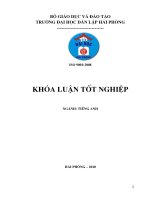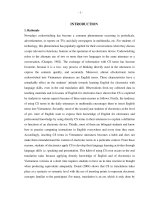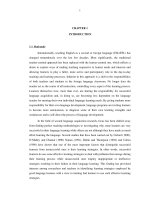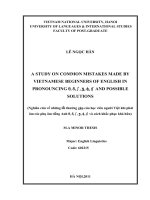A study on common hand gestures used by vietnamese and american
Bạn đang xem bản rút gọn của tài liệu. Xem và tải ngay bản đầy đủ của tài liệu tại đây (1.77 MB, 57 trang )
BỘ GIÁO DỤC VÀ ĐÀO TẠO
TRƯỜNG ĐẠI HỌC DÂN LẬP HẢI PHÒNG
-------------------------------
ISO 9001:2015
KHÓA LUẬN TỐT NGHIỆP
NGÀNH: NGÔN NGỮ ANH
Sinh viên
: Chu Phúc Hưng
Giảng viên hướng dẫn : ThS. Trần Thị Ngọc Liên
HẢI PHÒNG - 2018
BỘ GIÁO DỤC VÀ ĐÀO TẠO TRƯỜNG ĐẠI HỌC DÂN LẬP
HẢI PHÒNG -----------------------------------
A STUDY ON COMMON HAND GESTURES USED BY
VIETNAMESE AND AMERICAN
GRADUATION PAPER
Student
Class
Teacher
: Chu Phuc Hung
: NA1801
: MA. Tran Thi Ngoc Lien
HAI PHONG - 2018
BỘ GIÁO DỤC VÀ ĐÀO TẠO TRƯỜNG ĐẠI
HỌC DÂN LẬP HẢI PHÒNG
--------------------------------------
NHIỆM VỤ ĐỀ TÀI TỐT NGHIỆP
Sinh viên: Chu Phúc Hưng
Lớp: NA1801
Mã SV: 1412751085
Ngành: Ngôn ngữ Anh
Tên đề tài: A study on common hand gestures used by Vietnamese and
American
NHIỆM VỤ ĐỀ TÀI
1. Nội dung và các yêu cầu cần giải quyết trong nhiệm vụ đề tài tốt nghiệp
( về lý luận, thực tiễn, các số liệu cần tính toán và các bản vẽ).
……………………………………………………………………………..
……………………………………………………………………………..
……………………………………………………………………………..
……………………………………………………………………………..
……………………………………………………………………………..
……………………………………………………………………………..
……………………………………………………………………………..
……………………………………………………………………………..
2. Các số liệu cần thiết để thiết kế, tính toán.
……………………………………………………………………………..
……………………………………………………………………………..
……………………………………………………………………………..
……………………………………………………………………………..
……………………………………………………………………………..
……………………………………………………………………………..
……………………………………………………………………………..
……………………………………………………………………………..
……………………………………………………………………………..
3. Địa điểm thực tập tốt nghiệp.
……………………………………………………………………………..
……………………………………………………………………………..
……………………………………………………………………………..
CÁN BỘ HƯỚNG DẪN ĐỀ TÀI TỐT NGHIỆP
Người hướng dẫn thứ nhất:
Họ và tên:.............................................................................................
Học hàm, học vị:...................................................................................
Cơ quan công tác:.................................................................................
Nội dung hướng dẫn:............................................................................
Người hướng dẫn thứ hai:
Họ và tên:............................................................................. ................
Học hàm, học vị:...................................................................................
Cơ quan công tác:.................................................................................
Nội dung hướng dẫn:............................................................................
Đề tài tốt nghiệp được giao ngày tháng
năm
Yêu cầu phải hoàn thành xong trước ngày
tháng
Đã nhận nhiệm vụ ĐTTN
Đã giao nhiệm vụ ĐTTN
Sinh viên
năm
Người hướng dẫn
Hải Phòng,
ngày ......
tháng........ năm 2018
Hiệu trưởng
GS.TS.NGƯT Trần Hữu Nghị
PHẦN NHẬN XÉT CỦA CÁN BỘ HƯỚNG DẪN
1. Tinh thần thái độ của sinh viên trong quá trình làm đề tài tốt nghiệp:
……………………………………………………………………………..
……………………………………………………………………………..
……………………………………………………………………………..
……………………………………………………………………………..
……………………………………………………………………………..
……………………………………………………………………………..
……………………………………………………………………………..
2. Đánh giá chất lượng của khóa luận (so với nội dung yêu cầu đã đề ra trong
nhiệm vụ Đ.T. T.N trên các mặt lý luận, thực tiễn, tính toán số liệu…):
……………………………………………………………………………..
……………………………………………………………………………..
……………………………………………………………………………..
……………………………………………………………………………..
……………………………………………………………………………..
……………………………………………………………………………..
……………………………………………………………………………..
……………………………………………………………………………..
……………………………………………………………………………..
3. Cho điểm của cán bộ hướng dẫn (ghi bằng cả số và chữ):
……………………………………………………………………………..
……………………………………………………………………………..
……………………………………………………………………………..
Hải Phòng, ngày … tháng … năm
Cán bộ hướng dẫn
(Ký và ghi rõ họ tên)
CỘNG HÒA XÃ HỘI CHỦ NGHĨA VIỆT NAM
Độc lập - Tự do - Hạnh phúc
PHIẾU NHẬN XÉT CỦA GIẢNG VIÊN HƯỚNG DẪN TỐT NGHIỆP
Họ và tên giảng viên: ...................................................................................................
Đơn vị công tác:
........................................................................ ..........................
Họ và tên sinh viên:
Đề tài tốt nghiệp:
.......................................... Chuyên ngành: ...............................
...................................................................................................
........................................................... ........................................
Nội dung hướng dẫn:
.......................................................... ........................................
....................................................................................................................................
3. Tinh thần thái độ của sinh viên trong quá trình làm đề tài tốt nghiệp
............................................................................................................................. .................
.................... ..............................................................................................................................................
.................... ............................................................................................................................. .................
.................... .......................................................................................................................................... ....
.................... ............................................................................................................................. .................
.................... ............................................................................................................................. .................
4. Đánh giá chất lượng của đồ án/khóa luận (so với nội dung yêu cầu đã đề ra trong nhiệm vụ
Đ.T. T.N trên các mặt lý luận, thực tiễn, tính toán số liệu…)
.................... ............................................................................................................................. .................
.................... ..............................................................................................................................................
.................... ............................................................................................................................. .................
.................... ..............................................................................................................................................
.................... ............................................................................................................................. .................
.................... ............................................................................................................................. .................
3. Ý kiến của giảng viên hướng dẫn tốt nghiệp
Được bảo vệ
Không được bảo vệ
Điểm hướng dẫn
Hải Phòng, ngày … tháng … năm ......
Giảng viên hướng dẫn
(Ký và ghi rõ họ tên)
CỘNG HÒA XÃ HỘI CHỦ NGHĨA VIỆT NAM
Độc lập - Tự do - Hạnh phúc
PHIẾU NHẬN XÉT CỦA GIẢNG VIÊN CHẤM PHẢN BIỆN
Họ và tên giảng viên:
Đơn vị công tác:
Họ và tên sinh viên:
Đề tài tốt nghiệp:
..............................................................................................
........................................................................ .....................
...................................... Chuyên ngành: ..............................
......................................................................... ....................
1. Phần nhận xét của giáo viên chấm phản biện
..........................................................................................................................................
..........................................................................................................................................
..........................................................................................................................................
............................................................................................................................... ........
2. Những mặt còn hạn chế
..........................................................................................................................................
..........................................................................................................................................
..........................................................................................................................................
3. Ý kiến của giảng viên chấm phản biện
Được bảo vệ
Không được bảo vệ
Điểm phản biện
Hải Phòng, ngày … tháng … năm ......
Giảng viên chấm phản biện
(Ký và ghi rõ họ tên)
QC20-B19
TABLE OF CONTENTS
PART ONE: INTRODUCTION...........................................................................12
1. Rationale.......................................................................................................... 12
2. Aims of the study............................................................................................. 13
3. The research questions.....................................................................................13
4. Scope of the study............................................................................................13
5. Method of study............................................................................................... 14
6. Design of study................................................................................................ 14
PART TWO: DEVELOPMENT...........................................................................15
CHAPTER 1: LITERATURE REVIEW..............................................................15
1. Nonverbal Communication............................................................................ 15
1.1. Definition...................................................................................................... 15
1.2. Classification of nonverbal communication..................................................15
1.2.1. Gesture....................................................................................................... 16
1.2.2. Posture........................................................................................................16
1.2.3. Eyes contact............................................................................................... 17
1.2.4. Facial Expression.......................................................................................17
1.2.5. Touching.....................................................................................................18
1.2.6. Paralaguage................................................................................................ 18
1.2.7. Space, Artefacts and Environment.............................................................19
1.2.7.1.Space........................................................................................................19
1.2.7.3.Environment.............................................................................................20
1.3. The functions of non-verbal communication..............................................20
1.4. The importance of non-verbal communication...........................................21
1.5. Hand gesture in comunication.....................................................................21
1.5.1. What is the hand gesture?...........................................................................21
1.5.2. The importance and impact of hand gesture in communication................22
CHAPTER TWO:
AN
INVESTIGATION
INTO
COMMON
HAND
GESTURES USED BY VIETNAMESE AND AMERICAN PEOPLE AND
THE USE OF HAND GESTURE OF HPU’S STUDENTS................................24
QC20-B19
1. Common hand gestures used by Vietnamese and American people................24
1.1. Handshake.....................................................................................................24
1.2. Thumbs up – Thumbs down..........................................................................27
1.2.1. Thumbs up..................................................................................................28
1.2.2. Thumbs down.............................................................................................29
1.3. V Sign............................................................................................................30
1.4. Poiting finger.................................................................................................32
1.5. Crossed fingers..............................................................................................33
1.6. Finger Snapping............................................................................................35
2. The use of the commnon hand gestures of the student in HPU....................... 37
2.1. Data collection.............................................................................................. 37
2.1.1. The importance, frenquency and objects of using hand gesture of students
of English Department of HaiPhong Private University......................................37
2.2. The way to using hand gesture in communication of students of English
Department of HPU..............................................................................................40
2.2.1. Handshake..................................................................................................40
2.2.2. Thumbs up..................................................................................................41
2.2.3. Thumbs down.............................................................................................43
2.2.5. Pointing finger............................................................................................44
2.2.6. Finger Snapping.........................................................................................45
CHAPTER 3. IMPLICATION.............................................................................47
3.1. Difficulities in communication......................................................................47
3.2. Implication in teaching Hand gestures in HPU.............................................48
PART THREE: CONCLUSION...........................................................................51
1. Recapitulation.................................................................................................. 51
2. Reccomendations............................................................................................. 51
REFERENCES.....................................................................................................53
APPENDIX..........................................................................................................54
QC20-B19
ACKNOWLEDGEMENT
In the process of doing the graduation paper, I have received a lot of
help, assistance, guidance and encouragement from my teachers, family and
friends.
First and foremost, I would like to express my deepest gratitude to my
supervisor Ms. Tran Thi Ngoc Lien (MA), the Dean of Foreign Language
Department, Haiphong Private University, for her whole-hearted guidance
and support. Without his invaluable recommendations and advice, I could
not finish this thesis.
My sincere thanks are also sent to all the teachers of English
department at Haiphong Private University for their precious and useful
lessons during my four years study which have been then the foundation of
this graduation paper.
Last but not least, I would like to give my heartfelt thanks to my family,
my friends who always encourage and motivate me to complete this
graduation paper.
Hai Phong , October 2018
Chu Phuc Hung
QC20-B19
PART ONE: INTRODUCTION
1.Rationale
Communication is a process of sending and receiving information among
people. It is an integral part of the human existence, many people believe that
the significance of communication is like the importance of breathing.
In person life, we need to communicate to deal with various concerns and
problems of daily life. Communication is the foundation of all human
relationship. Firstly, strangers start talking and getting to know each other and
then the relationships are formed when they have more interaction and
communication. It helps people to express their ideas and feelings and at the
same time, helps us to understand emotion and thoughts of the others. As a
result, the positive or negative relationships will be created.
In communication, we have verbal and nonverbal communication. In
verbal communication, we talk face to face with other person by the use of
sounds, words, or speaking.
In contrast, nonverbal is nearly anything that sends an idea from one
person to another without the use of words, this includes gestures, facial
expressions, body movement, timing, touch, and anything else that
communicates without speaking. In the same statemen that we said, but through
different facial expressions or with different gestures, it can be different
meanings. In fact, it has been estimated that as much as 80 percent of
communication is about what is not being said. Rather, it's based on perceptions
of a person's gestures, eye contact, clothing, and environment.
Most of our gestures come from the hands, it is mainly used in
communication in daily life or in business. A hand gesture is whenever you
move your hand or head to express or emphasize an idea. And this is an
important part of your overall body language. The meanings of hand gestures
may be understood in various ways in different cultures.
QC20-B19
Misreading
about
the
meanings
of
hand
gestures
can
lead
misunderstanding about the culture or the meaning in communication of
partners. Thus, in this graduation paper, the use of hand gestures – an important
part of non-verbal communication – will be concentrated and analyzed, so that
they could help readers understand and improve their ability of speaking without
words.
Based on the importance and requirement of non-verbal language,
especially hand gestures, some useful hand gestures in daily life will be listed
and emphasized in this graduation paper. They are able to help young students
understand and practice in communication in different cultures
2.Aims of the study
The study is aimed at investigating hand gesture used by American and
Vietnamese people in nonverbal communication. Therefore, the following
objectives need fulfilling. The study is to:
-identify common hand gestures used by American and Vietnamese people in
communication
-figure out the meanings of hand gesture in the implication of teaching English
at HPU
-find out the challenges that HPU students encounter when using hand gestures
in non-verbal communication.
3.The research questions
-What are the common hand gestures used by American and Vietnamese
people
-What is the difference in using hand gestures in Vietnam and America?
-What challenges do HPU students encounter when using hand gestures in
non-verbal communication.
4.Scope of the study
Due to the limit of time and ability, the study is focused on six common
hand gestures but it cannot cover all the hand gestures used by American and
QC20-B19
Vietnamese people. Moreover, the study is restricted its application to teaching
English at HPU.
5.Method of study
In this the graduation paper, two main methods are used: the quantitative
and the qualitative method. To begin with, the former, we use statistical analysis
to figure out what hand gestures are commonly used by the American and
Vietnamese people. Also, this method is applied to find out and analyze the
frequency of the using hand gestures in communicationof HPU students and how
important it is to them. What’s more, a survey questionnaire is made to help the
researcher get to know about the habit and attitude of HPU students towards
hand gestures usage. Regarding the latter, it is used tojustify the importance of
using hand gestures in communication in general and of HPU students in
particular.
6.Design of study
The study is divided into four main parts:
The first part is the introduction which combines the reasons of choosing
the topic, the aim of the study, research question. The scope of the study as well
as the methods applied.
The second part is the development which includes three chapters:The first
chapter with theoretical background to provide readers with the knowledge of the
general nonverbal communication, especially hand gestures used in the life
The next chapter focused on the similarities and difference about some
common hand gestures between Vietnam and American. Besides, find out and
analysis of the using and understand hand gesture of HPU student
The third chapter is the implication of hand gestures in English teaching
The last part is the conclusion of the study. All of information from the
previous parts of the study is summarized in this part.
QC20-B19
PART TWO: DEVELOPMENT
CHAPTER 1: LITERATURE REVIEW
1.Nonverbal Communication
1.1.Definition
According
to
Knapp
(1972)
non-verbal
communication
just
demonstratesactions and expressions without using words, these meaningful
things
areshown.
Therefore,
non-verbal
communication
describes
“allcommunication events which transcend spoken or written words”. It
cannotbe confirmed as a full definition of non-verbal communication. Thus,
thereare many authors who have different opinions about this type
ofcommunication.
According to Levine and Adelman (1993) “Non-verbal communication
isthe “silent” language, including the use of gestures, facial expressions,
eyecontact, and conversational distance”. Body language and a minor part
ofenvironment language are emphasized but it is still not enough to show us
aclear view about non-verbal communication.
One more general viewed by Dwyer (2000) is that non-verbal
communicationcovers all parts of a message that are not encoded by words; for
example:voice, presence or gesture and motion.
In summary, within this paper, nonverbal communication is the process of
sending and receiving messages without using words, either spoken or written.
Nonverbal communication includes pitch, speed, tone and volume of voice,
gestures and facial expressions,body posture, stance, and proximity to the
listener, eye movements andcontact, and dress and appearance.
1.2.Classification of nonverbal communication
According to fundamental information, nonverbal communication can be
identified with the following categories: gesture, posture, eyes contact,
paralaguage, facial expression, touching and space
QC20-B19
1.2.1.Gesture
A gesture can be performed in combination with speech, as support, but
can also occur in situations where speech is absent, movements of the face, the
arms, the legs and the feet. (McNeil, 1992).
In "Nonverbal communication across cultures" (Forthcoming:163)Nguyen
Quang gives a full definition of gestures as “Gestures can beunderstood as the
movements of arms, legs and body which are usedindependently or with words in
communication in order to emphasize orreplace words, to control or display one's
feelings and attitudes, and toexpress one's thought”
Within this paper, gestures are body actions. Gesture can be transmitted
effectively andclearly as well as verbal communication, even it is more
effectively. Gesturesalso help us get the listeners attention. Without gestures our
world would bestatic and colorless.
1.2.2.Posture
Looking up the definition of posture in the Oxford Dictionary, we finds:
“a position of a person’s body when standing or sitting.” This is a fair
explanation for a dictionary but is unscientific in as far as it gives no inkling
about the mechanisms underlying posture
According to Ron Hruska Jr., MPA, PT (2000) “Posture is a reflection of
the “position” of many systems that are regulated, determined and created
through limited functional patterns. These patterns reflect our ability and
inability to breathe, rotate and rest symmetrically”
However, in this paper, posture is defined roughly as body language and
stance. Posture can provide a significant amount of important information on
nonverbal communication and emotional cues.
We can describe different posture as formal, relaxed, rigid, defendsive,
agressive, suggestive, sexy, slouched and awkard.
Examples of bad posture include slouching, towering, jaw thrusting and
arm crossing. These nonverbal behaviors can indicate feelings and attitudes
QC20-B19
toward another person. An example of good posture includes standing erect and
leaning forward. This communicates to a person that you are approachable,
receptive and friendly.
1.2.3.Eyes contact
Most of dictionaries showed that eyes contact occurs when two people
look at each other's eyes at the same time
However, according to the author of Evenesis Blogs belives that eyes
contact have a imporant role in communication, it is a form of body language
which is important during communication. How we present ourselves and
communicate with others aside from talking is by our body language. Our body
language speaks more than words which then logically accounts for a bigger
percentage of our communication skills. Therefore our eyes speaks volumes
about us and how we communicate.
In summary, in this graduation paper, eye contact is a type of nonverbal
communication that is strongly influenced by social behaviour. Through the
eyes, we can feel the attitude of partners in communication
For example, we also avoid a direct look from another person if we have
something to hide. The police use it as a means to detect if the person is telling
the truth or not. Or we keep eye contact with the focused and paying attention
for the person that you like.
1.2.4.Facial Expression
A facial expression is one or more motions or positions of the muscles
beneath the skin of the face. According to one set of controversial theories, these
movements convey the emotional state of an individual to observers. Facial
expressions are a form of nonverbal communication. They are a primary means
of conveying social information between humans, but they also occur in most
other mammals and some other animal species. (For a discussion of the
controversies on these claims, see Fridlund and Russell & Fernandez Dols)
In communication, human faces are incredibly expressive including the
eyes, eyebrows, mouth, and any other movement. Emotions such as anger,
QC20-B19
happiness, hurt, disgust, confusion, and boredom are all easily expressed with
facial movements.
1.2.5.Touching
Communicating through touch is another important nonverbal behavior. There
has been a substantial amount of research on the importance of touch in infancy and
early childhood. Harry Harlow's classic monkey study demonstrated how deprived
touch and contact impedes development. Baby monkeys raised by wire mothers
experienced permanent deficits in behavior and social interaction. Touch can be used
to communicate affection, familiarity, sympathy, and other emotions.
In this paper, touching can console or support the other person and
showfeelings such as affection, sexual interest or dominance. Hand
gesturesdemonstrate feelings and convey thoughts and words through
movement.
For example, hand shakes are acceptable almost everywhere, even
between strangers; however, kissing on the cheek, patting on the shoulder,
embraces, or touching other bodily parts aren't – for many people in Asia and
other parts of the world such actions are interpreted as an offense or even a
violation of one's private space. This is why you should avoid touching in some
culture while you should consider touching in other cultures.
1.2.6.Paralaguage
According to Paschalis Chliaras in Independent Science And Technology
College : “Paralanguage is the area of non-verbal communication that
emphasizes body language and voice nuances as means of expressing thoughts
and feelings. People normally use paralanguage multiple times per day and are
sometimes not even aware they are doing so”
However, through my researchs, paralanguage is that part of language
associated with, but notinvolving, the word system. It consists of the voice
qualities andvocalizations that affect how something is said rather than what is
said.Vocalizations, the tone of voice, rate of speaking and voice inflection arean
important part of the total message. For example: Voice qualities include pitch
QC20-B19
range, pitch control, rhythm control,tempo, articulation control and resonance.
Vocalizations (such as signing,groaning, volume, “um” and “ah”) also give clues
to the total message. Atired person will speak more slowly than usual; a
disappointed person mayspeak with a flat tone)
1.2.7.Space, Artefacts and Environment
According my researchs, space, artefacts and environment is external
factors in communication. But they still have effection to the result of
conversation.
The environment and social and cultural artifacts are vital for understanding
nonverbal communication. The environment refers to the physical place in which
communication takes place. Artifacts are the objects in the environment that can
provide some form of stimulus to the communicators. It is these concepts that
provide the context for nonverbal communication. Space is often associated with
social rank and is an important part of business communication. Thus, the space,
the environment and artifacts, there are a number of factors that can effect changes
in how individuals communicate non-verbally.
1.2.7.1. Space
In an interesting book entitled The Hidden Dimension, anthropologist
Edward T. Hall discusses space, how people structure it, and how space
influences communication."Proxemics" is the term Hall has coined for the
interrelated observations and theories of man's use of space as a specialized
elaboration of culture. Hall (1969) identified four distances that people maintain
between themselvesand others:
1.Intimate space is 0 – 45 cm.
2.Personal distance is 45 – 120 cm.
3.Social distance is 1.2 - 3.6 m.
4.Public distance is 3.6 m to out of sight.
For example, it might be considered rude to stand too close to someone in
one place but not another. It might be very common to touch someone's arm or
shoulder while talking in one place, but this could be considered rude in other
QC20-B19
places. In one country, you might greet someone with a kiss on the cheek, and in
other places this might be considered too intimate.
1.2.7.2. Artefacts
Artifacts are not just things that people leave behind when they are gone.
They can be things that people wear, believe in, or use on a regular basis. For
example, Red has been traditionally one of the favourite colours in Chinese
culture because the color represents happiness and wealth. While black in earlier
years had not enjoyed popularity among Chinese, today that color, particularly
glossy and brilliant black, has turned out to be a colour of luxury
1.2.7.3. Environment
Environment involves the physical and psychological aspects of the
communication context. More than the tables and chairs in an office,
environment is an important part of the dynamic communication process. The
perception of one’s environment influences one’s reaction to it. For example
they can be natural and artificial light, color, temperature, tables, chairs,desks,
lounges, plants, sound, artwork, magazines, and floor and wallcoverings all have
an impact. The environment should satisfy instincts,such as the need for privacy,
familiarity and security.
1.3.The functions of non-verbal communication
According to The Importance of Effective Communication, Edward G.
Wertheim (2008), nonverbal communication can play five roles:
Repetition:
It repeats and often strengthens the message you’re making
verbally.
Contradiction:
It can contradict the message you’re trying to convey, thus
indicating to your listener that you may not be telling the truth.
Substitution:
It can substitute for a verbal message. For example, your
facial expression often conveys a far more vivid message than words ever can.
Complementing:
It may add to or complement your verbal message. As a
boss, if you pat an employee on the back in addition to giving praise, it can
increase the impact of your message.
QC20-B19
Accenting:
It may accent or underline a verbal message. Pounding the
table, for example, can underline the importance of your message.
Functions of non-verbal communication are universal, no matter
whichcountry or context.
1.4.The importance of non-verbal communication
According to Pease (1984): “The fascinating thing is that the human
animalis rarely aware of his postures, movements and gestures that can tell
onestory while his voice may be telling another”.
In casual communication, according to Levine and Adelman, 93% of
themessage is conveyed by tone and facial expression; only 7% of themessage is
transmitted in words.
However, in this graduation paper, we have 3 reasons for the importance
of nonverbal communication:
Firstly, it is easier to remember what people see than what they hear.
Secondly, non-verbal communication occurs more than verbal
communication.
Thirdly, people can easily be deceived by verbal communication, but it is
much more difficult with non-verbal communication.
In conclusion, communication is an important aspect in human life. Itis
the way one expresses ones knowledge, emotions and skills. Non- verbal
communication plays an important role in the communicationprocess; it
determines how one interprets the information and actions of others. One needs
to beskilled in non-verbal communication and he should also be able tointerpret
it for smooth flow of communication in any relationship.When the non-verbal
signals do not match the words or action of thespeaker, it leads to
misunderstanding, confusion and mistrust amongthe audience.
1.5.Hand gesture in comunication
1.5.1.What is the hand gesture?
Hand gesture recognition is one of the important problems in vision related fields such as human-machine interaction, communication, and robotic.
QC20-B19
Hand gestures are expressive actions, which we display to communicate
our messages. It is a non-verbal mode of communication, wherein we show up
different movements of hands and fingers accompanied by various kinds of
facial expressions. They have a wide range of meanings, and they are also
emblematic of different religious and cultural traditions. Every individual
movement has a meaning symbolizing various forms of perceptions.
The meaning and significance of hand gestures can differ from one culture
to another. Although people and cultures tend to interpret them in their own way,
there are still some gestures which hold universal meanings, that is they mean
the same everywhere in the world.
In this paper, we focus on the common hand gestures and the way people
using it in Vietnam and America. Besides, we analysis and find out the different
meaning between them and when they have positive meaning or negative
meaning.
1.5.2.The importance and impact of hand gesture in communication
Hand gestures often help emphasize certain points of speeches
andstrengthen the speaker’s message. Research shows that stronger speakersuse
hand gestures, and here are some common motions people use whilespeaking.
People pay attention to the motions being taken during speeches.If you
purposely use your body to stress a certain idea, the audience ismuch more likely
to remember what you said. The movement drawsattention to what you are
saying at that moment and draws attention to theimportant parts of the speech. A
lively speaker leaves a larger impressionon listeners than an immobile
individual.
Using hand gestures can make the speaker moreanimated, and it is much
more pleasing to the eye to have a movinglecturer as opposed to a stationary
speaker the entire time. It is not that thelecturer is boring per say, but more that
using motions would prompt morepeople to stay alert during the presentation.
However, hand gestures maynot be the way to go for everyone. Do not
QC20-B19
randomly insert them intospeeches if you do not feel comfortable doing so
because it will only comeoff as unnatural and awkwardly placed.
From my analysis, I found three reasons why hand gesture is important in
communication:
1.Hand gestures can help you make the talking atmosphere active. With
these gestures other talkers can know your feeling directly. This can make the
conversation smoothly.
2.Hand gestures can help other people understand your main point
quickly. For example,people used to using different hand gestures to show their
different points. A good lecturer or a good talk usually use their gestures to tell
the audiences ‘this is the most important thing I want to say ‘.
3.Hand gestures or body gestures can help you talk fluently with the
people who speak other languages. Although most people of the world study
English, most of them can't speak English very well. So the hands gestures can
really help you make the conversation smoothly. For example, I'm a Vietnamese
and I can't use English very fluently. If l have a chance to talk with you face to
face, I can explain my idea better and have a good conversation with my hand
gesture
However, the students in Vietnam, especially HPU’s students seems not
found the importance of hand gesture in communication in daily life or in
bussiness. Through my survey, I realizes most of students still don’t understand
the meaning of some common hand gesture and the way use it in
communication.
QC20-B19
CHAPTER TWO: AN INVESTIGATION INTO COMMON HAND
GESTURES USED BY VIETNAMESE AND AMERICAN PEOPLE AND
THE USE OF HAND GESTURE OF HPU’S STUDENTS
1.Common hand gestures used by Vietnamese and American people
As in most cultures, non-verbal communication plays an important role in
Vietnamese and American society, sometimes to accompany and to reinforce
linguistic symbols, sometimes as to be a substitute for words.
Through my survey for students of English Department of HaiPhong
Private University, I found out some common hand gestures in Vietnam and
America is handshake, thumbs up, thumbs down, v sign, pointing finger, crossed
fingers and finger snapping.
However, with the own cultures in different countries, we may find both
similarities and differences in the meaning of hand gestures used by Vietnamese
and American people.
1.1. Handshake
The handshake has existed in some form or another for thousands of
years, but its origins are somewhat murky. One popular theory is that the gesture
began as a way of conveying peaceful intentions. By extending their empty right
hands, strangers could show that they were not holding weapons and bore no ill
will toward one another. Some even suggest that the up-and-down motion of the
handshake was supposed to dislodge any knives or daggers that might be hidden
up a sleeve. Yet another explanation is that the handshake was a symbol of good
faith when making an oath or promise. When they clasped hands, people showed
that their word was a sacred bond. “An agreement can be expressed quickly and
clearly in words,” the historian Walter Burkert once explained, “but is only made
effective by a ritual gesture: open, weaponless hands stretched out toward one
another, grasping each other in a mutual handshake.”
QC20-B19
Source: />A handshake is a globally widespread,brief greeting or parting tradition in
which two people grasp one of each other's like hands, in most cases
accompanied by a brief up-and-down movement of the grasped hands.
In Western, especially America, handshake is symbol for greeting for
daily life, business or any aspects. They believe that handshare is the best way to
greeting with strangers, they can easily understand the partners. Besides, itis also
a symbol of the united, in business or in politics, the business mans or
statesmans usually give the power handshakes for the partners to show the
welcome, the believe for the others in business relationship
Vietnamese people generally greet each other by joining hands and
bowing slightly to each other. However, in big cities, some men have adopted
the Western practice of shaking hands. Vietnamese women generally do not
shake hands with each other or with Vietnam War men but the custom is
acceptable between a Vietnamese woman and non-Vietnamese man. Vietnamese
also often refrain from shaking hands with a senior or someone of higher rank.
In urban areas, modernized young men and women shake hands. When saying
goodby, Vietnamese often shake hands or bow slightly. When greeting someone
of authority clasp both hands
QC20-B19









